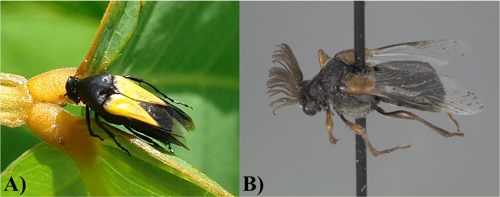We are pleased to announce a new article on Featured Creatures!
Take a sneak peek with this excerpt from the article: Ripiphoridae are a family of unusual parasitic beetles that are thought to be related to tumbling flower beetles (Coleoptera: Mordellidae) and blister beetles (Coleoptera: Meloidae). There is disagreement over the spelling of the family (Ripiphoridae) and genus (Ripiphorus) names. Here we use the original spelling that starts with only the letter “R”; however, an initial “Rh” has also been used in the scientific community (Rhipiphoridae and Rhipiphorus).
Generally, the biology of the family Ripiphoridae is poorly known. Ripiphorids parasitize bees and wasps (Hymenoptera), roaches (Blattodea), and wood-boring beetles (Coleoptera). However, the specific hosts for many ripiphorid species are unknown. Furthermore, only one sex (either male or female) has been described for several species, and the males and females of some species look different.
Two genera of Ripiphoridae infest hymenopteran (bee and wasp) nests: Macrosiagon Hentz (Fig. 1A) and Ripiphorus Bosc(formerly Myodites Latreille) (Fig. 1B). Species of Macrosiagon are parasites of a variety of Hymenopteran families including: Halictidae, Vespidae, Tiphiidae, Apidae, Pompilidae, Crabronidae, and Sphecidae. Ripiphorus species parasitize only bees in the families Halictidae and Apidae.
Figure 1. Adult specimens of the two genera of Ripiphoridae. A) Macrosiagon Hentz, and B) Ripiphorus Bosc. Photographs by Allen M. Boatman.
Available at: http://entnemdept.ufl.edu/creatures/misc/BEES/Ripiphorus.htm
Authors: David Owens, Ashley N. Mortensen, Jeanette Klopchin, William Kern, Jamie D. Ellis, Entomology and Nematology Department, University of Florida.
 0
0

